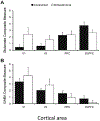Macroscopic gradients of synaptic excitation and inhibition in the neocortex
- PMID: 32029928
- PMCID: PMC7334830
- DOI: 10.1038/s41583-020-0262-x
Macroscopic gradients of synaptic excitation and inhibition in the neocortex
Erratum in
-
Publisher Correction: Macroscopic gradients of synaptic excitation and inhibition in the neocortex.Nat Rev Neurosci. 2024 Sep;25(9):643. doi: 10.1038/s41583-024-00847-5. Nat Rev Neurosci. 2024. PMID: 39014230 No abstract available.
Abstract
With advances in connectomics, transcriptome and neurophysiological technologies, the neuroscience of brain-wide neural circuits is poised to take off. A major challenge is to understand how a vast diversity of functions is subserved by parcellated areas of mammalian neocortex composed of repetitions of a canonical local circuit. Areas of the cerebral cortex differ from each other not only in their input-output patterns but also in their biological properties. Recent experimental and theoretical work has revealed that such variations are not random heterogeneities; rather, synaptic excitation and inhibition display systematic macroscopic gradients across the entire cortex, and they are abnormal in mental illness. Quantitative differences along these gradients can lead to qualitatively novel behaviours in non-linear neural dynamical systems, by virtue of a phenomenon mathematically described as bifurcation. The combination of macroscopic gradients and bifurcations, in tandem with biological evolution, development and plasticity, provides a generative mechanism for functional diversity among cortical areas, as a general principle of large-scale cortical organization.
Conflict of interest statement
Competing interests
The author declares no competing interests.
Figures





References
-
- Mountcastle VB The columnar organization of the neocortex. Brain 120, 701–722 (1997). - PubMed
-
- Hempel CM, Hartman KH, Wang X-J, Turrigiano G & Nelson SB Multiple forms of short-term plasticity at excitatory synapses in rat medial prefrontal cortex. J. Neurophysiol 83, 3031–3041 (2000). - PubMed
-
- Wang Y et al. Heterogeneity in the pyramidal network of the medial prefrontal cortex. Nat Neurosci 9, 534–542 (2006). - PubMed
Publication types
MeSH terms
Grants and funding
LinkOut - more resources
Full Text Sources

